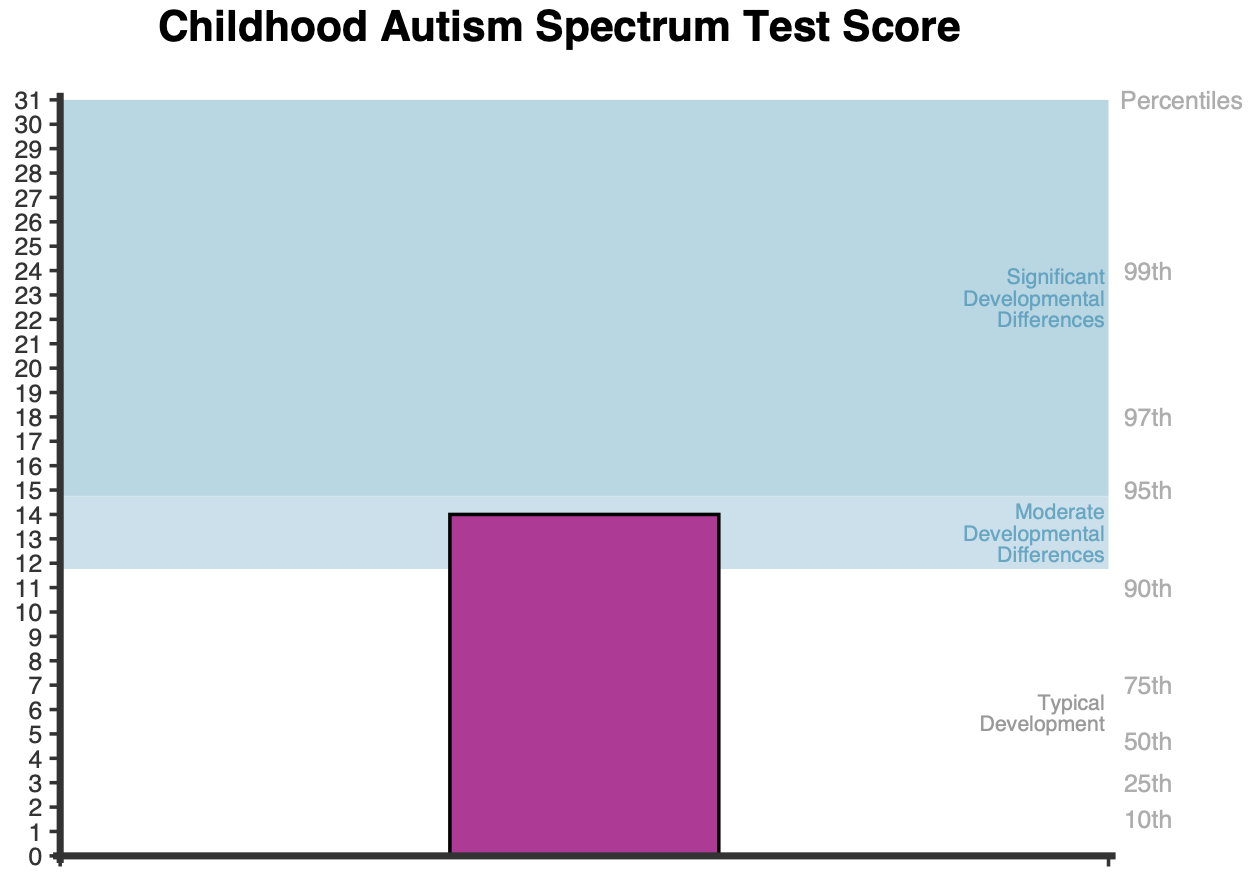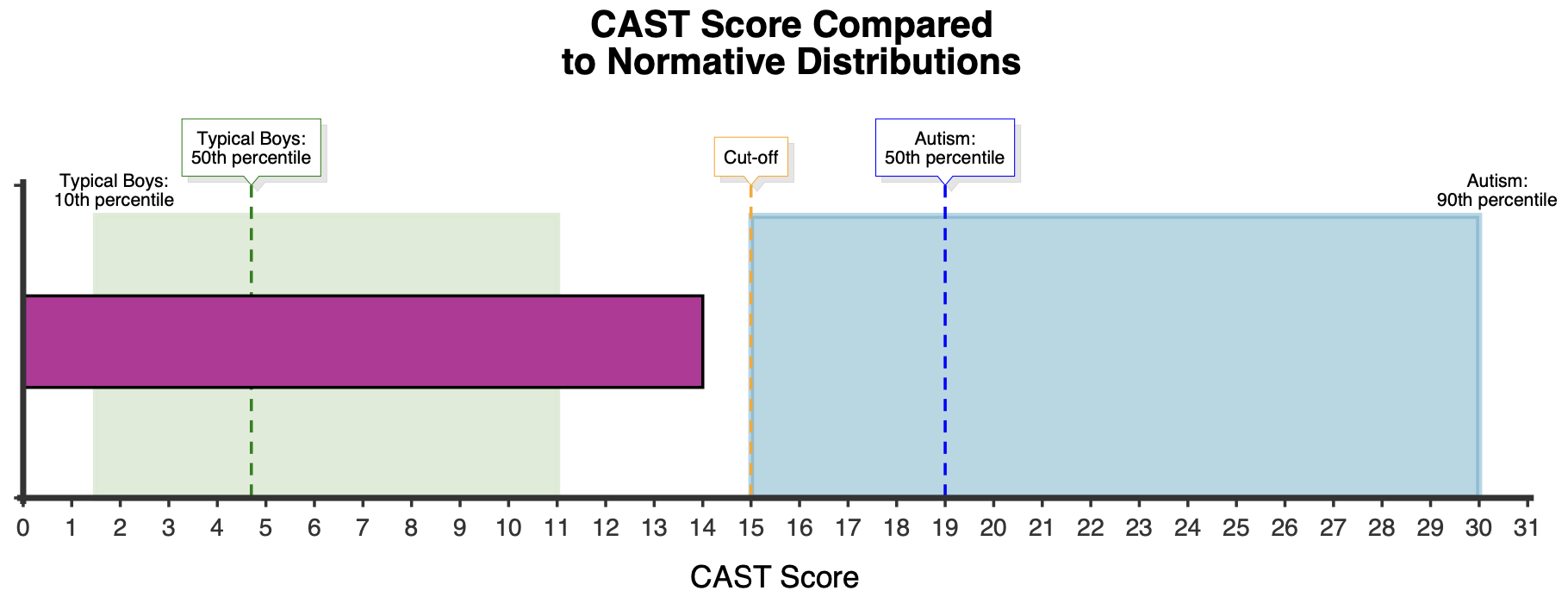The Childhood Autism Spectrum Test (CAST) is a screening tool designed to identify children who may have developmental differences in social and communication functioning. Parents, carers or teachers of children aged 4 to 11 answer a series of questions about a child’s development.
The Childhood Autism Spectrum Test (CAST), formerly known as the Childhood Asperger Syndrome Test, is a 39-item screening tool designed to identify children aged 4 to 11 years who may have developmental differences in social and communication functioning consistent with Autism or a related condition (Scott et al., 2002). Developed to facilitate early identification, the CAST is particularly useful in clinical settings for initial screening before comprehensive diagnostic assessment and in educational settings for identifying children who may benefit from further support.
The items ask parents about key aspects of social and communication functioning, including:
The CAST focuses on these areas because Autistic children often exhibit developmental differences in social and communication functioning. Validation studies comparing Autistic children and neurotypical children have demonstrated that the CAST accurately identifies children who have developmental differences consistent with Autism (Scott et al., 2002; Williams et al., 2005).
Further research has shown that boys typically score higher than girls on the CAST, which is an important consideration when interpreting scores (Williams et al., 2008).
It can be rated by a parent, caregiver or teacher. The CAST can be used by a qualified professional, such as a psychologist, as part of a comprehensive assessment. It should not be used as the sole means for diagnosis.
While primarily a screening tool, repeated administration of the CAST can help monitor changes in social and communication functioning over time and therefore response to treatment, given that the CAST demonstrates strong test-retest reliability (Williams et al., 2006).
The Childhood Autism Spectrum Test (CAST) has 39 questions, of which 31 items contribute to the total score, which ranges from 0 to 31, with higher scores indicating the presence of more developmental differences in social and communication functioning. The remaining items do not contribute to the total score, including six control questions about general development (Items 3, 4, 12, 22, 26, and 33) and two questions about support needs (Items 38 and 39).
The total score is categorised as follows, based on previous research and recommendations (Scott et al., 2002; Williams et al., 2005, 2008).

A cut-off score of 15 is the threshold at which Scott and colleagues (2002) suggest that the CAST can be used to discriminate between neurotypical children and children with Autism or a related condition characterised by developmental differences in social and communication functioning. About 1-2% of girls, 5% of boys, and 3% of children overall score 15 or above (Williams et al., 2008). A score of 15 or above indicates that the child may have significant developmental differences in social and communication functioning consistent with Autism or a related condition.
A score in the range of 12 to 14 (inclusive) indicates that the child has moderate developmental differences in social and communication functioning. About 3% of children score in this range, and thus about 6% of children score 12 or above (i.e., about 3% of girls and 9% of boys; Williams et al., 2008). Scores in this range are consistent with the higher-functioning end of the Autism spectrum (Scott et al., 2002), but could reflect various other neurodevelopmental or psychological conditions.

When interpreting CAST scores, it is recommended that clinicians take the following into account.
Interpretation of CAST scores should consider that boys typically score higher than girls, which is consistent with the higher rate of Autism in boys compared to girls (Williams et al., 2008). Boys are up to four times more likely to be described as having significant developmental differences in social and communication functioning compared to girls (i.e., 4.9% of boys and 1.3% of girls are described as having significant development differences). The total score is therefore converted to a percentile based on normative data for the child’s gender to contextualise the child’s score relative to the typical level of social and communication functioning among children of the same gender in the community (Williams et al., 2008). For children whose gender is non-binary or unspecified, percentiles are based on the average of the percentiles for girls and boys.
A graph comparing the child’s total score to a community sample of children of the same gender and a sample of Autistic children is presented, with shaded areas around the medians corresponding to scores between the 10th and 90th percentile (Scott et al., 2002; Williams et al., 2008). This graph contextualises the child’s score relative to scores for children in general and Autistic children.

The CAST can be used by a qualified professional, such as a psychologist, as part of a comprehensive assessment. It should not be used as the sole means for diagnosis.
Although the questions about support needs do not contribute to the total score, affirmative responses indicate that the child may have support needs that warrant further exploration. If identified, these support needs are listed in the report.
The Childhood Autism Spectrum Test (CAST) demonstrates good reliability and validity as a screening tool for Autism spectrum conditions in primary school-aged children (Scott et al., 2002).
The CAST shows good internal consistency (Cronbach’s alpha = .71 to .81, depending on the rater [i.e., parent or teacher] and the age of the child; Holmboe et al., 2014) and good test-retest reliability over a two-week interval (rs = .83; Williams et al., 2006), indicating that the CAST shows good stability of scores over time.
Using a cut-off score of 15, the CAST accurately discriminates between neurotypical children and children with Autism with 100% sensitivity, 97% specificity, and a positive predictive value of 50% (95% CI: 28-72%) (Williams et al., 2005).
Boys typically score higher than girls and boys are up to four times more likely to be described as having significant developmental differences in social and communication functioning compared to girls (Williams et al., 2008). The consistent differences in CAST scores between boys and girls highlight the importance of gender-specific norms. Masking behaviour, which is more common in autistic girls than boys (Hull et al., 2020), may lead to lower scores on the CAST.
Percentiles for CAST scores are presented below. Each score has a corresponding percentile which indicates the percentage of children who scored the same as or lower than the given score. For example, a total score of 14 corresponds to the 94th percentile among boys, indicating that 94% of the normative sample of boys have a total score of 14 or lower. The scores and corresponding percentiles are categorised as follows: Typical Development (White), Moderate Developmental Differences (Light Blue), and Significant Developmental Differences (Blue).

Scott, F. J., Baron-Cohen, S., Bolton, P., & Brayne, C. (2002). The CAST (Childhood Asperger Syndrome Test): Preliminary development of a UK screen for mainstream primary-school-age children. Autism, 6(1), 9-31. https://doi.org/10.1177/1362361302006001003
Holmboe, K., Rijsdijk, F. V., Hallett, V., Happé, F., Plomin, R., & Ronald, A. (2014). Strong genetic influences on the stability of autistic traits in childhood. Journal of the American Academy of Child and Adolescent Psychiatry, 53(2), 221-230. https://doi.org/10.1016/j.jaac.2013.11.001
Hull, L., Petrides, K. V., & Mandy, W. The female Autism phenotype and camouflaging: A narrative review. Review Journal of Autism and Developmental Disorders, 7, 306-317. https://doi.org/10.1007/s40489-020-00197-9
Scott, F. J., Baron-Cohen, S., Bolton, P., & Brayne, C. (2002). The CAST (Childhood Asperger Syndrome Test): Preliminary development of a UK screen for mainstream primary-school-age children. Autism, 6(1), 9-31. https://doi.org/10.1177/1362361302006001003
Williams, J., Scott, F., Stott, C., Allison, C., Bolton, P., Baron-Cohen, S., & Brayne, C. (2005). The CAST (Childhood Asperger Syndrome Test): Test accuracy. Autism, 9(1), 45-68. https://doi.org/10.1177/1362361305049029
Williams, J., Allison, C., Scott, F., Stott, C., Bolton, P., Baron-Cohen, S., & Brayne, C. (2006). The Childhood Asperger Syndrome Test (CAST): Test-retest reliability. Autism, 10(4), 415-427. https://doi.org/10.1177/1362361306066612
Williams, J. G., Allison, C., Scott, F. J., Bolton, P. F., Baron-Cohen, S., Matthews, F. E., & Brayne, C. (2008). The Childhood Autism Spectrum Test (CAST): Sex differences. Journal of Autism and Developmental Disorders, 38(9), 1731-1739. https://doi.org/10.1007/s10803-008-0558-6
NovoPsych’s mission is to help mental health services use psychometric science to improve client outcomes.
© 2023 Copyright – NovoPsych – All rights reserved